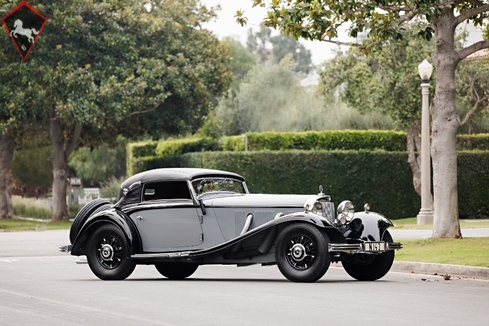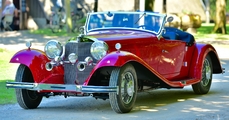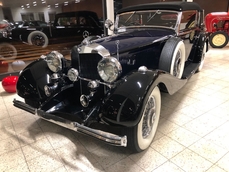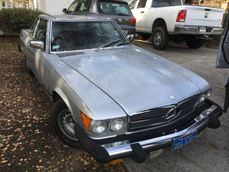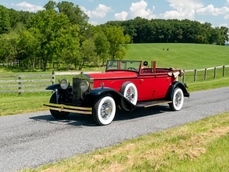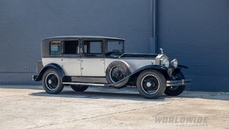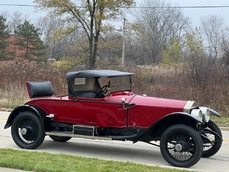Mercedes-Benz 500K Cabriolet A 1935
Allgemeine Beschreibung :
1935 Mercedes-Benz 500K Cabriolet AAuthentic inside and out, this 500K boasts of matching numbers and is perhaps one of the finest examples of the 11 remaining Cabriolet As. One of the most desirable of the pre-war Mercedes-Benz body styles, this 500K Cabriolet A represents the very definition of luxury, style and elegance. When Mercedes-Benz introduced its 500K at the Berlin Motor Show in 1934 it was very much charting the future of automobiles. Besides the Kompressor helping to produce some 160 hp, the car would also incorporate external exhausts and a frame that sported fully independent suspension. But Mercedes-Benz also initiated something else with its 'Sindelfingen' moniker. Throughout much of the first half of the 20th century many of the exclusive chassis offered to the public would come with custom-built coach bodies built by outside coachbuilders. Sindelfingen would certainly give the appearance of being an outside coachbuilder but was, in fact, Mercedes' own in-house coachbuilding element. This would, in many ways, help to foster car companies with their own in-house design firms and builders and would place a much greater emphasis within the factory itself to design and build its own special bodies. Sindelfingen would work because it offered a rather extensive catalog of potential body styles for each of its more select models. And, amongst the coachbodies made available for the 500K chassis, one of the more privileged would be the Cabriolet A designed and built by Sindelfingen. Amongst the total of 342 units that would be produced over the course of two years just 33 examples would be fitted with Cabriolet A body-styling.One of those 33 would be chassis 105379. Baron Silfverschiold of Gasevadholm, Sweden would be immediately smitten by the 500K and would place an order for his own in November of 1934. The Baron would specify his 500K to be complete with left-hand-drive, gray paint and a blood-red pigskin leather interior. The car would be finally completed toward the end of April 1935 and would be thereafter delivered to the Baron who would then move and have the car re-registered to his estate, the Castle Koberg in Vastergotland. The 500K Cabriolet A had certainly come home. 105379 would remain with the Baron throughout World War II but would eventually be parked in 1948 when it suffered a tire puncture. While a seemingly straight-forward issue to rectify, the rear wheel nut would be incorrectly threaded and would lead to the car being unused for another couple of years. Then, in September of 1950, Charles-Emile von Oelrich would purchase the car from the Baron and would have the car repaired. Being restored to use, Herr Von Oelrich would immediately take the car on several long-distance outings. Throughout the 1950s, the Cabriolet A would change hands a number of times and would even be owned a short period of time by the music director Birger Ludvigsson. Allan Karlsson would then come to own the car and would remark it's only flaw was the fact that it attracted a large crowd everywhere it went. Gosta Westerberg would come to own the car and would be determined to have it restored. The restoration work would begin in 1962 and would be completed by July of 1963. Soon thereafter the car would again change hands. This time, well-known collector Sven Harnstrom would come to own the car and would enter it in a number of various club meetings over the course of his nearly decade long ownership. When the car was sold to Svante Rosen, the car would continue to enter various collector car events. All throughout this time the 500K would remain in Sweden. However, in 1983 would leave its adopted homeland and would come to be part of a collection in West Germany. In the late 1980s, at the owner's request, Rolf Bunte would restore the Cabriolet A. Bunte would work tirelessly not just to restore the car, but to make sure everything functioned as intended and factory correct. This effort would end up setting a benchmark for the future. Such a beautifully-restored car would not be easy to part with. Therefore, it wouldn't be until 2004 when the car would be sold again, this time to a resident of the Netherlands. Remaining a part of a very private collection, the 500K remained as if completely original. Because of the work of the restoration, and the regular maintenance and upkeep, recent work done on the car would consist of just a mechanical tuning and touch-ups here and there to restore it to near brand-new condition.A very desirable body style, one of just 33 examples built on the 500K chassisFascinating, well-known ownership historyHandsome older restoration, still in attractive conditionExcellent colors, well-suited to this coachworkClassic Car Club of America (CCCA) Full ClassicPrice: $2,450,000
1935 Mercedes-Benz 500K Cabriolet A is listed zu verkaufen on ClassicDigest in New York by Gullwing Motor Cars for $2450000.
Fakten der Auto
Karosserietyp : Auto Marke : Mercedes-Benz Modell : 500K Ausführung : Cabriolet A Hubraum : 0.0 Modelljahr : 1935 Lage : Astoria Fahrzeug Anmeldung : Undefiniert
2450000 $
People who viewed this Mercedes-Benz 500K also viewed similar Mercedes-Benz listed at ClassicDigest
Other cars listed for sale by this dealer
über Mercedes-Benz
In den Annalen der Automobilgeschichte entfaltet sich die Reise von Mercedes-Benz wie eine Erzählung voller Ingeniosität seiner Gründer. Im Jahr 1886 schuf Karl Benz den Benz Patent Motorwagen, eine Kreation, die als das weltweit erste Automobil in die Geschichte eingehen sollte. Unwissentlich markierte dieser Moment den Ursprung dessen, was sich zu einem weltweit renommierten Premium-Autohersteller entwickeln würde. Die finanzielle Basis dieses bahnbrechenden Unternehmens wurde interessanterweise von Karls Ehefrau, Bertha Benz, bereitgestellt, was eine bemerkenswerte Partnerschaft demonstrierte, die den Ton für das Erbe von Mercedes-Benz setzen sollte.Nicht weit entfernt entstand eine parallele Erzählung, als die Daimler-Motoren-Gesellschaft, gegründet von Gottlieb Daimler und Wilhelm Maybach, die Bühne betrat. Im Jahr 1901 enthüllten sie ihr Auto unter dem mittlerweile berühmten Namen "Mercedes", was auf Spanisch "Geschenk Gottes" bedeutet. Dieser Name wurde auf das Auto auf Wunsch von Emil Jellineks Tochter verliehen, dem Vertriebspartner der Daimler-Motoren-Gesellschaft. Die Räder der Innovation wurden in Bewegung gesetzt.
Springen wir vorwärts ins Jahr 1926, ein entscheidendes Jahr, das die Fusion von Daimler mit Benz & Cie. sah, was zur Geburt von Daimler-Benz führte. Die Fusion führte zur Übernahme von "Mercedes-Benz" als das renommierte Markenzeichen für ihre Automobile und verschmolz die Legenden zweier visionärer Unternehmen zu einer.
Entgegen konservativen Wahrnehmungen entfaltet sich die Geschichte von Daimler-Benz als Chronik von Branchenneuheiten. Von der Einführung des Wabenkühlers über den Schwimmervergaser bis zur bahnbrechenden Einführung von Vierradbremsen im Jahr 1924 trieb Daimler-Benz kontinuierlich die Grenzen der automobilen Innovation voran. Der Dieselantrieb des Mercedes-Benz 260 D im Jahr 1936 markierte den Beginn von Dieselmotoren in Personenkraftwagen. Der ikonische Mercedes-Benz 300SL Gullwing schrieb Geschichte als das erste Auto mit direkter Kraftstoffeinspritzung, wenn auch der winzige 2-Takt-Motor des Gutbrod Vorrang beanspruchen kann.
Sicherheitsinnovationen wurden zum Markenzeichen, mit Béla Barényis patentiertem Sicherheitszellen-Design in den "Ponton"-Modellen im Jahr 1951, das Front- und Heck-Knautschzonen umfasste. Der W116 450SEL 6.9 führte die Einführung des Antiblockiersystems (ABS) ein, eine weitere wegweisende Sicherheitsfunktion. Vom ersten serienmäßigen Airbag bis hin zu vielen weiteren Innovationen wurde das Erbe der "Ersten" weiter in das Gewebe von Daimler-Benz eingeschrieben.
Auf seiner über hundertjährigen Reise hat Mercedes-Benz nicht nur Autos produziert, sondern automobile Ikonen geschaffen. Der SSKL, 710 SSK Trossi Roadster, 770K Grosser, 540K Spezial Roadster, 300SL Gullwing, W100 600 Pullman, W111 280SE 3.5 Flachkühler, W113 230SL Pagode, W109 300 SEL 6.3 und W201 2.3-16 Cosworth sind Zeugnisse des Engagements der Marke für Ingenieurkunst.
Die donnernden Silberpfeile, oder "Silberpfeile", darunter der W 25, W 125, W154, W165 und W196, schufen ein Erbe der Dominanz auf der Rennstrecke. Diese Maschinen waren nicht nur Autos; sie waren Ausdruck von Präzision, Geschwindigkeit und einem unbezwingbaren Geist, der die Konkurrenz im Staub zurückließ.
Während Mercedes-Benz in die Zukunft schreitet, tut es dies nicht nur als Automobilhersteller, sondern als Hüter eines Erbes, als Fackelträger der Innovation und als Leuchtturm automobiler Exzellenz. Der Weg in die Zukunft wird zweifellos die Fortsetzung der Verschmelzung von modernster Technologie, zeitlosem Design und dem unerschütterlichen Engagement für die Festlegung neuer Standards in der Welt der Automobile erleben.
